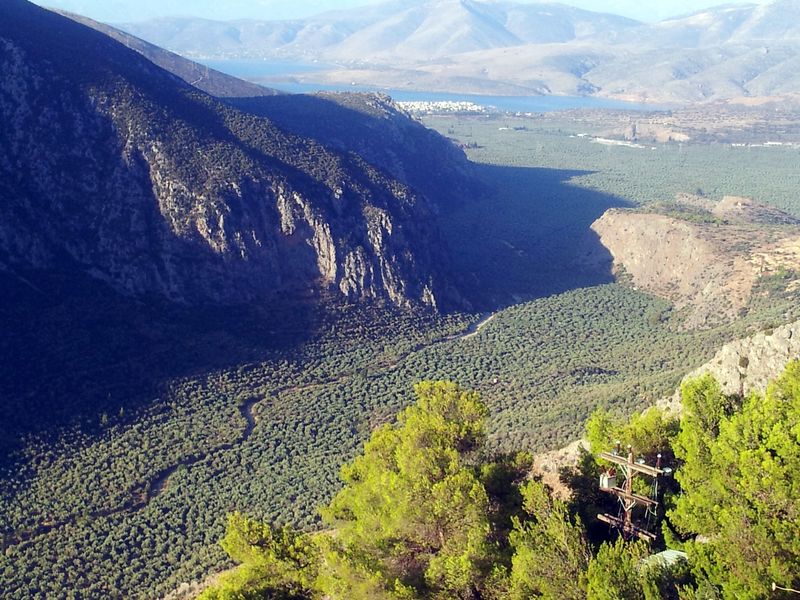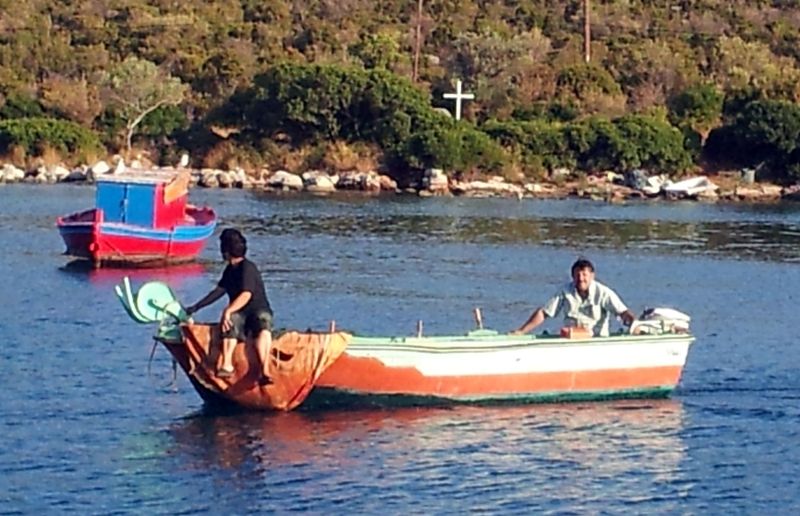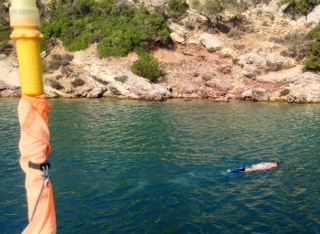Jackie's recent colourful observations and pics

37:31.065N 23:26.006E 21 September 2014 - Anchorage west of Poros Harbour/Poros Island (East Peloponnese) I sat here in the cockpit at 6:30 am when it was still dark. Progressively, the cockerels took over from the little owl that sang all night in the pine trees above our anchorage here in Russian Bay. As the sun rose, the timid song of tits could be heard in the pine trees. Later, a jay bird came to drink (fresh water surging into the bay?) and a bright blue kingfisher sat on our yellow land line to gulp the fish it had just caught. What a lovely sight! Remaining with the fauna of Poros island; I did some snorkelling in Yerolimena Bay to check the depths of our anchorage's swinging circle.
Checking our swinging circle clearance and holding A large octopus was resting on the sea bed. They usually spend the day hidden in the rocks but this one seemed to feel safe in the murky water, its colour perfectly adapted to the sea bed; I could hardly see it. I dived down to take a closer look and could watch how the octopus immediately started its transformation. Like time-lapse images in David Attenborough's documentaries showing the growth of a plant or a cloud formation in seconds, this octopus started to "bloom". It blew itself into a threatening pose and each of its 8 arms was positioned in petal-shape around its body. Not only did it change its shape, but both edges of each arm turned bright blue and his head suddenly displayed three black spots making it look like a threatening mask. Amazing! The three nights spent in the 3,500 year old town of Galaxidi, prior to transiting the Corinth Canal, were delightful for its most welcoming and warm locals and the attractive infrastructure around its narrow harbour. The small town's renovated "nautical" museum is a gem. We were very lucky to be guided through its treasures by an author who recently published Galaxidi's history in poetry form. It is hard to imagine 300 square riggers anchored this bay, when Galaxidi was a thriving harbour and even the first Greek harbour in the 18th and 19th century. Delphi has not changed much in 30 years ;-) other than its museum which nicely alternates displays in natural light and artificial light. We arrived early enough to be ahead of the bus loads of tourists and I walked all the way up to the stadium to take pictures. What a stunning sight!  Looking down from Delphi towards the sea and Itea, with a sea of olive trees in the foreground Every family owns some land in this valley and, as for one of them, gets some 800 litres of olive oil/year from their trees. 2013 was not a good year with less than 500 litres for them. An average of 5 kg of olives is needed for 1 litre of olive oil and the harvest starts in October/November ending in March, depending on the type of olives. The big Kalamata olives of the Peloponnese obviously require less olives for 1 litre of oil than the small ones growing in this valley.  Delphi and the remains of the Apollo temple A few days later, we entered the Corinth Canal shortly before 1pm, lucky to have the sun still shining on the deck for brighter photographs. The high, steep walls of the canal engulfed our convoy of three so small looking yachts. With a toll of 310€ in our case, this makes it the most expensive canal per kilometre in the world! After sailing under the second longest suspension bridge in the world in the Gulf of Patras one week ago, here is yet another piece of a world record on Greek territory.  Transiting the Corinth Canal  If this is not Greece, what is?: |
